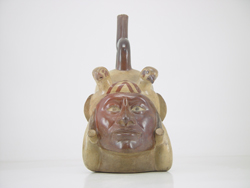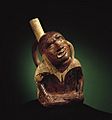Moche portrait vessel facts for kids
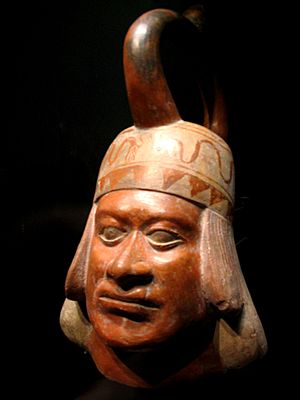
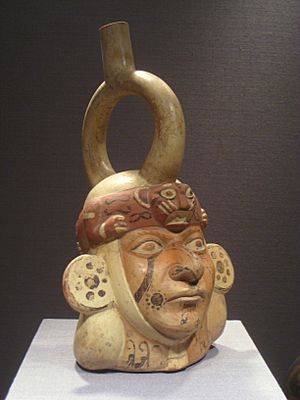
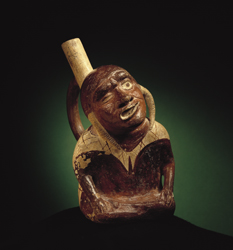
Moche portrait vessels are special clay pots made by the ancient Moche people in Peru. These pots show very detailed and lifelike faces of people. They are unique because they are some of the most realistic human pictures found from before Christopher Columbus came to the Americas.
Contents
Who Were the Moche People?
The Moche culture was a powerful group that lived a long time ago, from about 100 to 800 CE. They lived on the northern coast of Peru. Their land was between the big Pacific Ocean and the tall Andes mountains.
The Moche people were good farmers. They also fished a lot to get food. Their society had different levels of people, like leaders and regular citizens.
What Do Moche Portrait Vessels Look Like?
Most Moche portrait vessels show just the heads of people. But some of them show full human figures. These vessels were made to hold liquids, like water or other drinks.
Almost all of the faces on these pots are adult men. Sometimes, you might see a young boy. However, no portrait vessels of adult women have been found yet. The faces are very realistic. They even show things like harelips or missing eyes, which means they weren't trying to make people look perfect.
Size and Colors
These pots come in different sizes. They can be from about 6 to 45 centimeters tall. Most of them are between 15 and 30 centimeters tall.
Moche pottery usually has red paint on a light cream background. Sometimes, you can also find white or black paint. Most of the portraits are three-dimensional, meaning they stick out. Some also have extra fine line paintings on their surface.
Where Are Moche Vessels Found Today?
More than 900 different Moche portrait vessels have been photographed by the University of California, Los Angeles. Most of these vessels were found by people digging them up without proper archaeological methods. This means we don't always know exactly where they came from.
These pots were mostly found in graves. But people also used them during their lives. We know this because some pots show signs of wear and have been repaired.
The Famous Huaco Retrato Mochica
One very famous Moche portrait vessel is called the Huaco Retrato Mochica. This special pot was made around 600 CE. It shows a Moche ruler.
The ruler on the pot wears a cloth turban on his head. On top of the turban is a headdress with a two-headed bird and feathers. The ruler also wears round earrings. You can see similar earrings in the "Gold and Silver Gallery" at the Larco Museum.
We don't know the exact place where this pot was first found. But other discoveries suggest it might have come from the tomb of an important Moche leader. Archaeologists have found similar headdresses, made of reeds, in other Moche tombs.
Rafael Larco Hoyle, a famous collector, received this piece from his father. It is said that his father kept this pot when he gave the rest of his collection to a museum in Spain. Later, Rafael Larco Hoyle opened his own museum, the Larco Museum, where this amazing pot can be seen.
Images for kids
-
Moche portrait vessel, Quai Branly Museum, around 100—700 CE, 16 x 29 x 22 cm
-
Moche portrait vessel, around 100—500 CE, Worcester Art Museum
-
Portrait vessel showing a face with paralysis, Larco Museum
See also
 In Spanish: Huaco retrato moche para niños
In Spanish: Huaco retrato moche para niños


